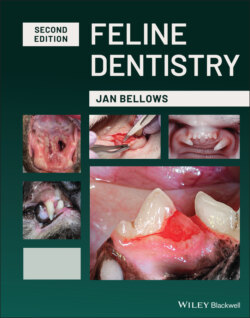Читать книгу Feline Dentistry - Jan Bellows - Страница 30
1.12 Alveolar Bone
ОглавлениеAlveolar processes house the alveoli, which support the teeth by providing attachment for the fibers of the periodontal ligament. An alveolus can be divided into two parts:
1 Alveolar bone proper, which is a thin layer of bone surrounding the root that allows attachment to the periodontal ligament.
2 Supporting alveolar bone, which consists of compact, cortical, or cancellous bone on the vestibular and oral aspects of the alveolar process. The alveolar bone proper is also referred to as the cribriform plate. It covers the alveolar socket and is identified on radiographs as lamina dura (Figure 1.10).
Figure 1.9 (a) Sagittal section revealing the periodontal ligament location (arrow). (b) Intraoral radiograph of the left maxillary canine demonstrating the periodontal ligament space.
Figure 1.10 Lamina dura (arrows pointing to the white line surrounding the tooth root).
The alveolar bone and cortical plates are thickest in the mandible. The shape and structure of the trabeculae of spongy bone reflect the stress‐bearing requirements of a particular site. In some areas, alveolar bone is thin with no spongy bone.
The alveolar bone height is in equilibrium between bone formation and bone resorption. When bone resorption exceeds formation, the alveolar bone height is reduced (Figure 1.11a,b).
